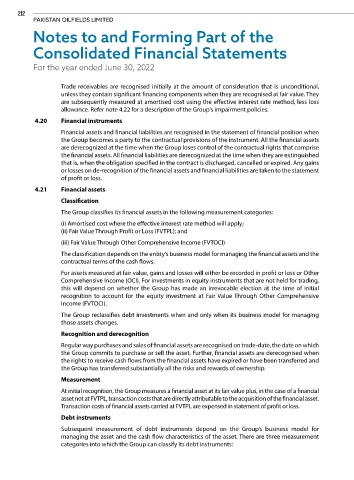Page 214 - Pakistan Oilfield Limited - Annual Report 2022
P. 214
212
PAKISTAN OILFIELDS LIMITED
Notes to and Forming Part of the -
Consolidated Financial Statements
For the year ended June 30, 2022
Trade receivables are recognised initially at the amount of consideration that is unconditional,
unless they contain significant financing components when they are recognised at fair value. They
are subsequently measured at amortised cost using the effective interest rate method, less loss
allowance. Refer note 4.22 for a description of the Group's impairment policies.
4.20 Financial instruments
Financial assets and financial liabilities are recognised in the statement of financial position when
the Group becomes a party to the contractual provisions of the instrument. All the financial assets
are derecognized at the time when the Group loses control of the contractual rights that comprise
the financial assets. All financial liabilities are derecognized at the time when they are extinguished
that is, when the obligation specified in the contract is discharged, cancelled or expired. Any gains
or losses on de-recognition of the financial assets and financial liabilities are taken to the statement
of profit or loss.
4.21 Financial assets
Classification
The Group classifies its financial assets in the following measurement categories:
(i) Amortised cost where the effective interest rate method will apply;
(ii) Fair Value Through Profit or Loss (FVTPL); and
(iii) Fair Value Through Other Comprehensive Income (FVTOCI)
The classification depends on the entity’s business model for managing the financial assets and the
contractual terms of the cash flows.
For assets measured at fair value, gains and losses will either be recorded in profit or loss or Other
Comprehensive Income (OCI). For investments in equity instruments that are not held for trading,
this will depend on whether the Group has made an irrevocable election at the time of initial
recognition to account for the equity investment at Fair Value Through Other Comprehensive
Income (FVTOCI).
The Group reclassifies debt investments when and only when its business model for managing
those assets changes.
Recognition and derecognition
Regular way purchases and sales of financial assets are recognised on trade-date, the date on which
the Group commits to purchase or sell the asset. Further, financial assets are derecognised when
the rights to receive cash flows from the financial assets have expired or have been transferred and
the Group has transferred substantially all the risks and rewards of ownership.
Measurement
At initial recognition, the Group measures a financial asset at its fair value plus, in the case of a financial
asset not at FVTPL, transaction costs that are directly attributable to the acquisition of the financial asset.
Transaction costs of financial assets carried at FVTPL are expensed in statement of profit or loss.
Debt instruments
Subsequent measurement of debt instruments depend on the Group’s business model for
managing the asset and the cash flow characteristics of the asset. There are three measurement
categories into which the Group can classify its debt instruments:

